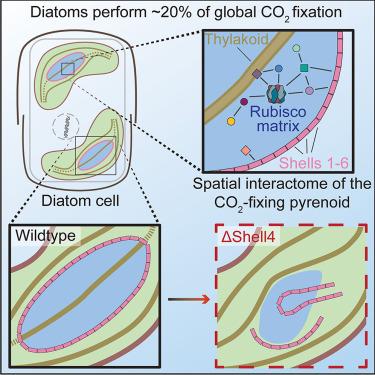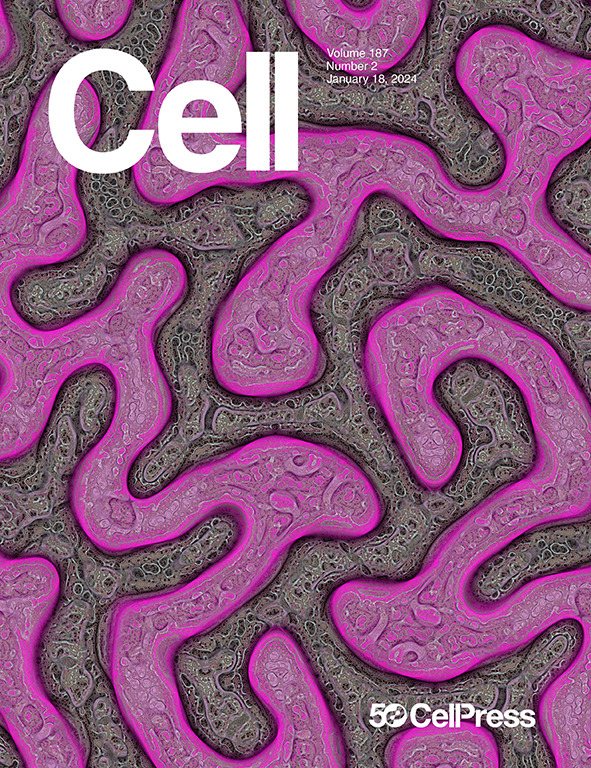A protein blueprint of the diatom CO2-fixing organelle
IF 45.5
1区 生物学
Q1 BIOCHEMISTRY & MOLECULAR BIOLOGY
引用次数: 0
Abstract
Diatoms are central to the global carbon cycle. At the heart of diatom carbon fixation is an overlooked organelle called the pyrenoid, where concentrated CO2 is delivered to densely packed Rubisco. Diatom pyrenoids fix approximately one-fifth of global CO2, but the protein composition of this organelle is largely unknown. Using fluorescence protein tagging and affinity purification-mass spectrometry, we generate a high-confidence spatially defined protein-protein interaction network for the diatom pyrenoid. Within our pyrenoid interaction network are 10 proteins with previously unknown functions. We show that six of these form a shell that encapsulates the Rubisco matrix and is critical for pyrenoid structural integrity, shape, and function. Although not conserved at a sequence or structural level, the diatom pyrenoid shares some architectural similarities to prokaryotic carboxysomes. Collectively, our results support the convergent evolution of pyrenoids across the two main plastid lineages and uncover a major structural and functional component of global CO2 fixation.

硅藻固定二氧化碳细胞器的蛋白质蓝图
硅藻是全球碳循环的核心。硅藻碳固定的核心是一个被忽视的细胞器,称为类火绒体(pyrenoid),浓缩的二氧化碳在这里被输送到密布的 Rubisco。硅藻类焦磷酸能固定全球约五分之一的二氧化碳,但这一细胞器的蛋白质组成在很大程度上是未知的。利用荧光蛋白标记和亲和纯化-质谱分析,我们为硅藻类热释蛋白生成了一个高置信度的空间定义的蛋白-蛋白相互作用网络。在我们的类焦磷酸相互作用网络中,有 10 个蛋白质具有以前未知的功能。我们的研究表明,其中六种蛋白质形成了一个包裹 Rubisco 基质的外壳,对于类焦磷酸结构的完整性、形状和功能至关重要。虽然在序列或结构水平上没有保守性,但硅藻类核苷酸与原核生物的羧基体在结构上有一些相似之处。总之,我们的研究结果支持了类火绒体在两个主要质体系中的趋同进化,并揭示了全球二氧化碳固定的一个主要结构和功能组成部分。
本文章由计算机程序翻译,如有差异,请以英文原文为准。
求助全文
约1分钟内获得全文
求助全文
来源期刊

Cell
生物-生化与分子生物学
CiteScore
110.00
自引率
0.80%
发文量
396
审稿时长
2 months
期刊介绍:
Cells is an international, peer-reviewed, open access journal that focuses on cell biology, molecular biology, and biophysics. It is affiliated with several societies, including the Spanish Society for Biochemistry and Molecular Biology (SEBBM), Nordic Autophagy Society (NAS), Spanish Society of Hematology and Hemotherapy (SEHH), and Society for Regenerative Medicine (Russian Federation) (RPO).
The journal publishes research findings of significant importance in various areas of experimental biology, such as cell biology, molecular biology, neuroscience, immunology, virology, microbiology, cancer, human genetics, systems biology, signaling, and disease mechanisms and therapeutics. The primary criterion for considering papers is whether the results contribute to significant conceptual advances or raise thought-provoking questions and hypotheses related to interesting and important biological inquiries.
In addition to primary research articles presented in four formats, Cells also features review and opinion articles in its "leading edge" section, discussing recent research advancements and topics of interest to its wide readership.
 求助内容:
求助内容: 应助结果提醒方式:
应助结果提醒方式:


